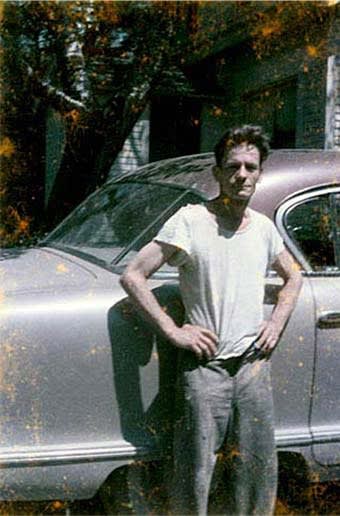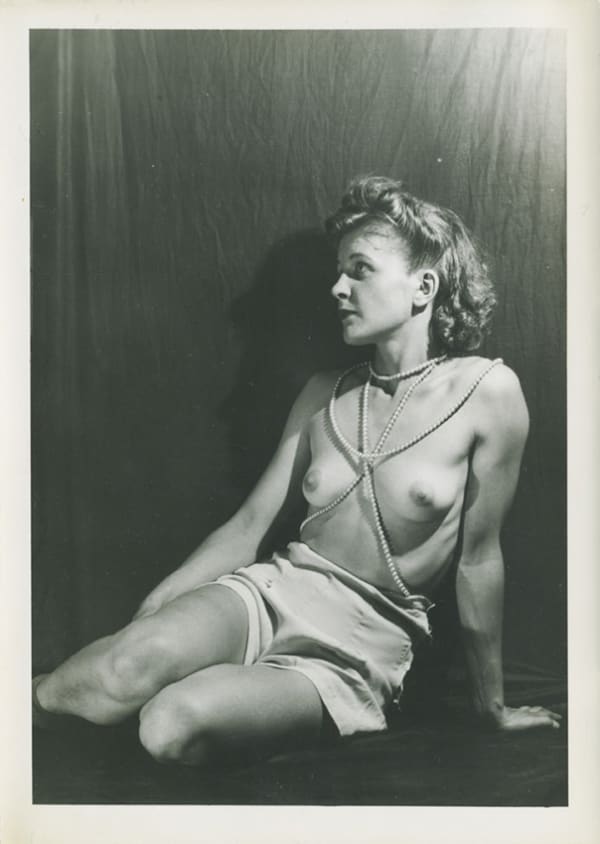Eugene Von Bruenchenhein 1910-1983
A bakery worker by day, Eugene Von Bruenchenhein was a photographer, painter, sculptor, and poet by night. Although he had full confidence in his talent (calling himself a “Freelance Artist—Poet and Sculptor—Inovator [sic]—Arrow maker and Plant man—Bone artifacts constructor—-Photographer and Architect—Philosopher”), his oeuvre was known only to his wife and a few others in his lifetime. He was born in Marinette, Wisconsin, and lived most of his life in Milwaukee, where he met his wife, Evelyn Kalka (ten years his junior), in 1939. They lived modestly in a small house that his father, a sign painter, had built, but their everyday life was rich with imagination. Von Bruenchenhein shot countless erotic photographs of Evelyn, whom he nicknamed “Marie,” his muse and queen of the kingdom of their bungalow.
In the portraits, Marie poses in every stage of dress and undress, in ordinary attire or luscious fabrics, with tin crowns, flowers, or Christmas ornaments. Von Bruenchenhein staged and styled the photographs with materials and props at hand, such as densely patterned drapes and quilts for backdrops, and he printed the images in his home darkroom. While some portraits of Marie are dramatic and seductive, others are quotidian and evoke an innocent sensuality. Most are black-and-white, and some are hand-tinted with capricious hues. Although Von Bruenchenhein was influenced by the pinup culture of the 1940s and 1950s, his photographic work—all revolving around Marie—offers something subtler, a convergence of imagination and domesticity, a shared intimacy between wife and husband, both of whom have real presence in the final images.
Von Bruenchenhein never finished high school and was completely self-taught in art. After his mother died when he was seven, his father remarried, and Von Bruenchenhein’s stepmother, a former schoolteacher, writer, and painter of floral still lifes, became his mentor. Enormously prolific, he left behind several thousand works, including sculptures made from poultry bones, concrete masks, musical instruments, poetry, prose, and paintings. The latter—which he rendered with his bare fingers, edges of corrugated cardboard, or brushes made from Marie’s hair—depict other-worldly landscapes with mysterious plantlike forms and apocalyptic visions evincing his fear and fascination with the Cold War and the nuclear bomb. When Von Bruenchenhein died in January 1983, his home was crammed full with his unseen oeuvre. That same year, Daniel Nycz, a close friend, stirred the interest of the Milwaukee Art Museum in the work, and by September the John Michael Kohler Arts Center in Wisconsin began cataloguing the entire collection. Since then, Von Bruenchenhein’s work has been exhibited widely and accessioned into the collections of the Kohler Arts Center (Sheboygan, Wisconsin), the Milwaukee Art Museum, the High Museum of Art (Atlanta), Intuit: The Center for Intuitive and Outsider Art (Chicago), the Los Angeles County Museum of Art, the Smithsonian American Art Museum (Washington, D.C.), the Nelson-Atkins Museum of Art (Kansas City, Missouri), the Philadelphia Museum of Art, the New Orleans Museum of Art, the American Folk Art Museum (New York), and the Collection de l’Art Brut (Lausanne, Switzerland).
-
 Untitled (Marie wearing lace tablecloth), c. 1940s
Untitled (Marie wearing lace tablecloth), c. 1940s -
 Untitled (Marie wearing lace tablecloth), c. 1940s
Untitled (Marie wearing lace tablecloth), c. 1940s -
 Untitled (Marie with criss-cross pearls, dark background), c. 1940s
Untitled (Marie with criss-cross pearls, dark background), c. 1940s -
 Untitled (Marie with crochet panties, sweetheart pillow on floor), c. 1940s
Untitled (Marie with crochet panties, sweetheart pillow on floor), c. 1940s -
 Untitled (Marie with floral halter top, flower in hair, hibiscus background), c. 1940s
Untitled (Marie with floral halter top, flower in hair, hibiscus background), c. 1940s -
 Untitled (Marie with floral halter top, flower in hair, hibiscus backround), c. 1940s
Untitled (Marie with floral halter top, flower in hair, hibiscus backround), c. 1940s -
 Untitled (Marie with floral halter top, flowers in hair), c. 1940s
Untitled (Marie with floral halter top, flowers in hair), c. 1940s -
 Untitled (Marie), c. 1940s
Untitled (Marie), c. 1940s








